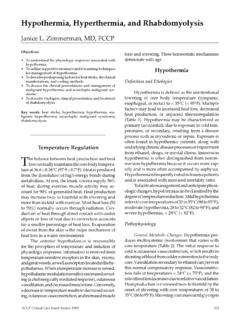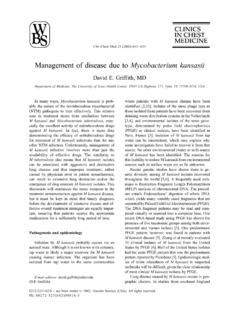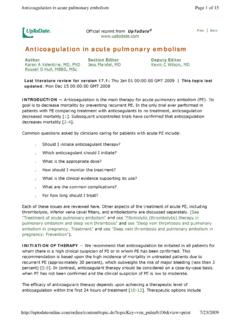Transcription of Pulmonary embolism: an unsuspected killer - …
1 Pulmonary embolism : anunsuspected killerTorrey A. Laack, MDa,b,c,d,*, Deepi G. Goyal, MDb,caDepartment of Pediatric and Adolescent Medicine, Mayo Medical School,Mayo Clinic, 200 First Street SW, Rochester, MN 55905, USAbDepartment of Emergency Medicine, Mayo Medical School, Mayo Clinic,200 First Street SW, Rochester, MN 55905, USAcMayo Emergency Medicine Residency, Mayo Medical School, Mayo Clinic,200 First Street SW, Rochester, MN 55905, USAdDepartment of Pediatrics, Mayo Medical School, Mayo Clinic,200 First Street SW, Rochester, MN 55905, USAThe accurate diagnosis of Pulmonary embolism (PE) is crucial. PE iscurrently the third leading cause of death in the United States with 50,000to 100,000 estimated deaths per year and an incidence of to 1 per 1000[1 4].
2 PE is a leading cause of unexpected deaths in hospitalized patients anda major source of medical malpractice lawsuits[5]. However, the diagnosis ismissed more often than it is made. One author conservatively estimates thatmore than half of fatal PE cases are not even suspected antemortem[6].Prior autopsy studies consistently have shown the rate to be even higher, atapproximately 70%[7 11]. Conversely, in patients in whom the diagnosis isconsidered, the prevalence of PE is only 25% to 35%[12,13]. Therefore,clinicians generally miss PE when it is present and suspect it when it is is truly an unsuspected killer with profound clinical patients in whom PE is diagnosed and treated have a mortalityrate of only 3% to 8%[3,14,15], those in whom the diagnosis is missed havea fourfold to sixfold greater mortality[3,6,15].
3 Before the use of heparin, surgical interventions were the only treatmentoptions available for PE with a mortality rate approaching 100%[16].Heparin first was administered to treat PE in the 1930s, but concerns over itssafety in this setting prevented more widespread use. It was not until 1960that the benefits of anticoagulation therapy were confirmed[17]. Beginning* Corresponding author. Department of Emergency Medicine, Mayo Medical School,Mayo Clinic, 200 First Street SW, Rochester, MN 55905, Laack).0733-8627/04/$ - see front matter 2004 Elsevier Inc. All rights Med Clin N Am22 (2004) 961 983in the 1960s, the use of fibrinolytics was studied; fibrinolytics were reservedprimarily for unstable patients with PE[16].
4 With the advent of effectivetherapy, the accurate diagnosis of thromboembolic disease became many deaths are attributed to undiagnosed Pulmonary emboli,the actual incidence of PE in the general population and the risk ofmortality or morbidity from an individual Pulmonary embolus are un-known. A high incidence of asymptomatic PE has been shown in patientswith deep venous thrombosis (DVT)[18 22], suggesting that PE may becommon and only infrequently may lead to death. Although some studieshave found mortality rates from untreated PE ranging from 25% to 30%,these studies involved patients with other comorbidities that likelycontributed to the adverse outcomes[17,23,24].
5 Other studies involving pa-tients without coexisting cardiopulmonary disease have found that mortalityeven with untreated or recurrent PE was significantly lower[22,24 27].A follow-up study of the untreated patients with PE from the ProspectiveInvestigation of Pulmonary embolism Diagnosis (PIOPED) revealeda mortality rate from PE of only 5% (1 in 20)[27].Given the fact that anticoagulation carries with it significant bleedingrisks and that not all cases of PE cause morbidity or mortality, the risk ofmisdiagnosis of PE is not limited to missing the diagnosis. Incorrectly diag-nosing PE in patients in whom it is absent or inconsequential unnecessarilyexposes them to the risks inherent with long-term anticoagulation the accurate diagnosis of PE is crucial to maximizing patientoutcomes, this article focuses on atypical presentations, unique challenges incertain patient populations, and current diagnostic strategies for thromboembolism (VTE) is a disease with a spectrum of mani-festations that include thrombophlebitis, DVT, and PE.
6 Most pulmonaryemboli have their origin in clots in the iliac, deep femoral, or popliteal emboli also can originate from sources in the upper extremities,central vascular access devices, heart, and vena caval filters[28 30]. The siteof the DVT does not seem to be as important as previously was thoughtbecause PE can occur from any site of DVT formation[31]. Calf veinthrombosis, previously considered relatively benign, propagates above theknee in approximately 80% and may cause PE without first extendingproximally[16]. Likewise, although superficial thrombophlebitis is generallybenign, it can extend into the deep venous system and pose a risk for PE[32].
7 In many instances of PE, no peripheral source of thrombosis is first described the process of thrombosis as involving a triad ofstasis, hypercoagulability, and endothelial injury[33]. Risk factors for PEcan be inherited or acquired (Box 1) and must be considered whenassessing a patient s probability of PE[29,30,35]. The strongest risk factor Laack, Goyal / Emerg Med Clin N Am 22 (2004) 961 983 VTE seems to be a history of prior thromboembolic disease[35].Inaddition, malignancy and surgery are well known to be associated withVTE. Certain malignancies, such as tumors affecting the lung, brain,ovaries, and pancreas, are especially prone toward predisposing patients toVTE[29], as are neurosurgical and orthopedic surgical procedures[34].
8 Major trauma patients are a high-risk patient population that deservesparticular attention because PE is the third most common cause of death inthese patients[2,36]. One study of victims of major trauma revealed thatnearly 60% had a DVT, most of whom were asymptomatic[37].Despite the clinical significance of risk factors for VTE, Morgenthalerand Ryu[9]found that 12% (11 of 92) of patients with PE as the cause ofdeath at autopsy lacked any known risk factor. Risk factors must be takeninto account in conjunction with the patient s history and presentation, butan absence of risk factors does not reliably exclude the diagnosis of presentationThe presentation of PE is occasionally dramatic, but more commonlypatients present with subtle clinical findings, or they may be completelyBox 1.
9 Risk factors predisposing to venous thromboembolismInherited risk factorsAntithrombin III deficiencyProtein C deficiencyProtein S deficiencyFactor V Leiden mutationAcquired risk factorsPrior history of venous thromboembolismMalignancySurgeryTraumaCe ntral venous access devicesPregnancy and the puerperiumImmobilization (travel, paralysis, bedridden state)Congestive heart failureMyocardial infarctionStrokeAdvanced ageSmokingObesityOral contraceptives/hormone replacement Laack, Goyal / Emerg Med Clin N Am 22 (2004) 961 983asymptomatic. This situation contributes to the large number of cases thatare missed on initial presentation. The classic findings of hemoptysis,dyspnea, and chest pain are insensitive and nonspecific for a diagnosis ofPE, with fewer than 20% having this classic triad.
10 The incidence of commonsymptoms in patients suspected of having PE is depicted inTable 1 [38]. Oneprospective observational study found that the single historical finding mostsensitive for PE was unexplained dyspnea. Even this finding was absent,however, in 8% of the patients studied[39]. Although unexplained chestpain or dyspnea always should lead to the consideration of PE, the fact thatpresentations of PE are often subtle mandates that the clinician not over-look the diagnosis based on a lack of these single physical examination finding is sensitive or specific for 1shows the prevalence of various signs in patients suspected of havingPE[38].











